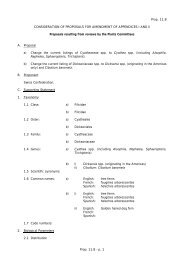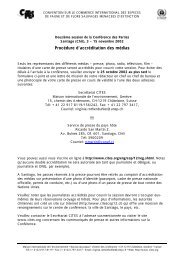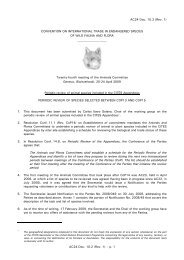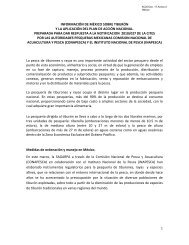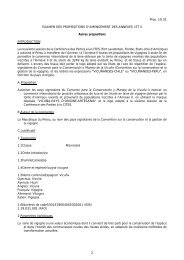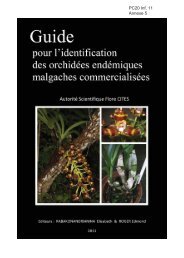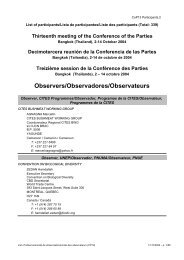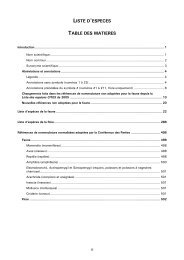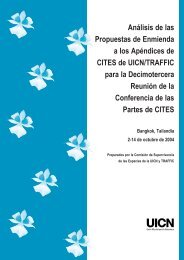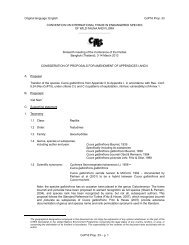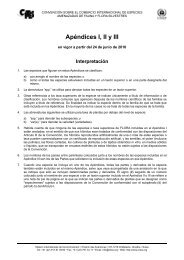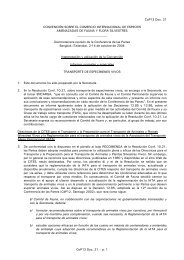Lamna nasus - Cites
Lamna nasus - Cites
Lamna nasus - Cites
Create successful ePaper yourself
Turn your PDF publications into a flip-book with our unique Google optimized e-Paper software.
Draft Proposal to list <strong>Lamna</strong> <strong>nasus</strong> in Appendix II - prepared by Germany in January 2012<br />
Toothfish fishing vessels, and with strict measures in force to protect sharks in Argentinian waters (live sharks<br />
greater than 1.5 m must be released if caught), catches are likely to be minimal. There are observers on all<br />
Argentinean fleets, and an observer report for sharks (including <strong>Lamna</strong> <strong>nasus</strong>) will be released later in 2012<br />
(Ramiro Sanchez, pers. comm.).<br />
6. Utilisation and trade<br />
Until recently, a lack of species-specific landings and trade data made it impossible to assess the proportions<br />
of global catches that supply national demand and enter international trade, although the high commercial<br />
value of the species has been documented through market surveys (Fleming and Papageorgiou 1997, Rose<br />
1996, unpublished TRAFFIC Europe 2003 market surveys). Survey findings indicated that the demand for<br />
fresh, frozen or processed L. <strong>nasus</strong> meat and fins is sufficiently high to justify the existence of an international<br />
market, while other products include dried-salted meat for human consumption, oil, and fishmeal for fertilizer<br />
(Compagno 2001). The extent of national consumption versus export by range States can vary considerably,<br />
depending upon local demand. For example, high levels of seafood consumption in Brazil, including by some<br />
Asian communities, makes it likely that porbeagle meat is consumed by domestic markets although fins may<br />
be exported. Other States with lower domestic seafood consumption, such as Uruguay, are likely to export its<br />
landings of porbeagle, mixed with mako, another high value shark meat (Andres Domingo pers. comm.).<br />
Following the introduction by the EU of new species-specific codes in 2010, some international trade data for<br />
this species is now becoming available (albeit only for trade involving the EU).<br />
6.1 National utilisation<br />
L. <strong>nasus</strong> has long been one of the most valuable (by weight) of marine fish species landed in Europe, similar<br />
in value to swordfish meat and sometimes marketed as such (Gauld 1989; Vas and Thorpe 1998; TRAFFIC<br />
Europe market surveys; Vannucinni 1999). Porbeagle may also be utilised nationally in some range States for<br />
liver oil, cartilage and skin (Vannuccini 1999). Low-value parts of the carcass may be processed into<br />
fishmeal. There is limited utilisation of jaws and teeth as marine curios. No significant national use of L.<br />
<strong>nasus</strong> parts and derivatives has been reported, partly perhaps because records at species level are not readily<br />
available, and partly because quantities landed are now so small, particularly in comparison with other shark<br />
species.<br />
The species is utilised for sports fishing in the USA and some EU Member States. Catches are either retained<br />
for meat and/or trophies, or tagged and released. Low levels of L. <strong>nasus</strong> are taken by game fishers off New<br />
Zealand South Island, but estimates of the recreational harvest is unavailable and probably negligible since L.<br />
<strong>nasus</strong> usually occur over the outer continental shelf or beyond (MFSC 2008).<br />
6.2 Legal trade<br />
All international trade in <strong>Lamna</strong> <strong>nasus</strong> products is unregulated and legal. Prior to 2010, all global trade in<br />
porbeagle <strong>Lamna</strong> <strong>nasus</strong> products was reported under general Customs commodity codes for shark species and<br />
could not be identified. In 2010, the EU introduced new species-specific Customs codes for fresh and frozen<br />
<strong>Lamna</strong> <strong>nasus</strong> (porbeagle) products (excluding shark fins) and amended previous codes covering most shark<br />
species to now exclude this species. Table 4 shows the old and new relevant Customs codes for porbeagle.<br />
There is a considerable market for porbeagle products within the European Union (EU), with EU Member<br />
States having taken 60–75% of FAO’s global records of porbeagle catch in 2006 and 2007 (prior to<br />
establishment of a TAC, which was reduced to zero for EU waters and EU fleets in 2010). EU market demand<br />
must now be met by imports. EU imports and exports of this species in 2010 and 2011, reported in<br />
EUROSTAT, are summarized in Tables 5 and 6 (these do not include internal EU trade). Other<br />
countries/territories do not have species-specific codes in place for trade in this species, and continue to report<br />
its trade under general shark commodity codes, preventing analysis.<br />
The following porbeagle range States were the principal suppliers of fresh and frozen porbeagle meat to the<br />
EU (excluding other EU countries) in 2010 and 2011 (EU importer shown in brackets): South Africa (Italy),<br />
Japan (Spain), Morocco (Spain), Norway (Germany and Denmark) and the Faroe Islands (Denmark). A total<br />
of 45,000kg of porbeagle meat, worth EUR 118,294, was imported during this two year period.<br />
South Africa does not have any directed fisheries for porbeagle, although one or two sharks per trip are<br />
apparently caught in the South African pelagic long-line fishery. Therefore, the high quantities imported from<br />
South Africa into the EU are likely to be derived from foreign flagged vessels fishing outside South Africa’s<br />
EEZ and discharging in South African ports. These may include by-catch of Japanese vessels targeting<br />
southern bluefin tuna or catches of Korean, Taiwanese or other vessels targeting tuna and tuna-like species<br />
Page 9 of 14<br />
AC26 Doc. 26.2, Annex 1 – p. 9<br />
AC26 Doc. 26.2<br />
Annex / Anexo /Annexe<br />
(English only / únicamente en inglés / seulement en anglais)




